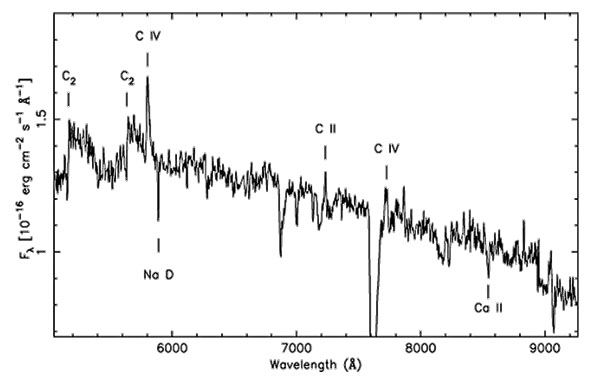During the H-alpha survey of the Galactic Plane (IPHAS,
www.iphas.org)
carried out at the Isaac Newton telescope, a remarkable planetary
nebula was discovered. It was named as the Necklace nebula for its
prominent ring of bright knots. The nebula also displays a pair of
jets moving in the direction perpendicular to the ring.
The formation of asymmetric structures such as rings and jets in
planetary nebulae (PNe) has been a matter of debate for a long time. The
most popular hypothesis is that these features are produced in
interacting binaries: indeed, time-series photometry of the core of
the Necklace revealed a close binary star at its centre, with an
orbital period of 1.2 days (Corradi et al., 2011, MNRAS, 410, 1349).
This implies that the system has gone through a common-envelope (CE)
phase right before the nebula ejection. Therefore, the Necklace nebula
is one of the first few PNe for which a clear association between jet's
production and binarity has been established.
In addition, deep VLT+FORS2 and WHT+ACAM spectra revealed that the
secondary star of the Necklace binary system is a carbon dwarf
(Miszalski, Boffin & Corradi, 2012). As carbon is not
produced in unevolved stars, the secondary star of the Necklace must
have accreted it from the primary, presumably from its wind when it
was an AGB star, and during the accretion process, the jets would have
formed.
For the first time, jet ejections can therefore be
reliably related to accretion onto the secondary star of the system
right before the CE phase, as predicted by some models.
The kinematical age of the jets, larger than the age of the main body of
the nebula, which is supposed to be ejected during the short CE phase,
also supports the hypothesis of pre-CE accretion.
In addition, the
carbon-rich nature of the secondary star of the Necklace challenges
the existing models of carbon dwarf formation and CE evolution. Its
short orbital period of 1.16 day, is in fact only marginally
reproduced by the existing carbon dwarf population models.
 |
ACAM spectrum obtained at inferior conjunction of the
secondary star of the Necklace binary system. At this phase, the side
of the secondary that is not irradiated by the very hot PN central star
faces us, and reveals its carbon-rich nature, as revealed by several
molecular bands and ionized atomic lines.
[ JPEG ]. |
More information:
Miszalski, B., Boffin, H.M.J., Corradi, R.L.M., 2012, "A carbon dwarf wearing a Necklace: first proof of accretion in a
post-common-envelope binary central star of a planetary nebula with jets". MNRAS, 428, L39. Paper.
Corradi, R.L.M., Sabin, L., Miszalski, B., et al., 2011, "The Necklace: equatorial and polar outflows from the binary
central star of the new planetary nebula IPHASX J194359.5+170901", MNRAS, 410,
1349. Paper.



